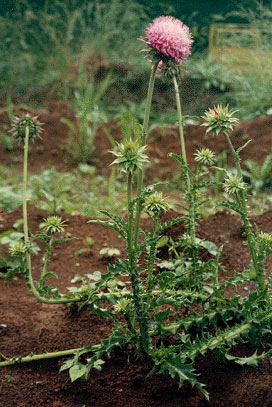
Carduus nutans, with the common names musk thistle, nodding thistle, and nodding plumeless thistle, is a biennial plant in the daisy and sunflower family Asteraceae. It is native to regions of Eurasia.

Onopordum acanthium is a flowering plant in the family Asteraceae. It is native to Europe and Western Asia from the Iberian Peninsula east to Kazakhstan, and north to central Scandinavia, and widely naturalised elsewhere, with especially large populations present in the United States and Australia. It is a vigorous biennial plant with coarse, spiny leaves and conspicuous spiny-winged stems.

Cirsium vulgare, the spear thistle, bull thistle, or common thistle, is a species of the Asteraceae genus Cirsium, native throughout most of Europe, Western Asia, and northwestern Africa. It is also naturalised in North America, Africa, and Australia and is an invasive weed in some areas. It is the national flower of Scotland.

Carduus is a genus of flowering plants in the family Asteraceae, and the tribe Cardueae, one of two genera considered to be true thistles, the other being Cirsium. Plants of the genus are known commonly as plumeless thistles. They are native to Eurasia and Africa, and several are known elsewhere as introduced species. This genus is noted for its disproportionately high number of noxious weeds compared to other flowering plant genera.

Cirsium arvense is a perennial species of flowering plant in the family Asteraceae, native throughout Europe and western Asia, northern Africa and widely introduced elsewhere. The standard English name in its native area is creeping thistle. It is also commonly known as Canada thistle and field thistle.
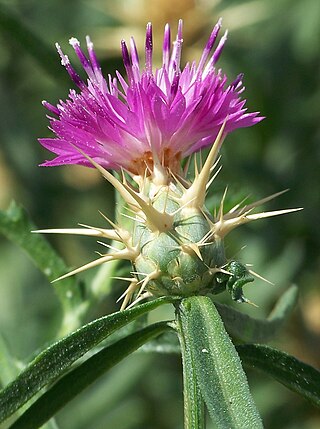
Centaurea calcitrapa is a species of flowering plant known by several common names, including red star-thistle and purple star thistle. It is native to Europe but is rarely found there, it is known across the globe as an introduced species and often a noxious weed. The species name calcitrapa comes from the word caltrop, a type of weapon covered in sharp spikes.

Centaurea solstitialis, the yellow star-thistle, is a species of thorny plant in the genus Centaurea, which is part of the family Asteraceae. A winter annual, it is native to the Mediterranean Basin region and invasive in many other places. It is also known as golden starthistle, yellow cockspur and St. Barnaby's thistle.
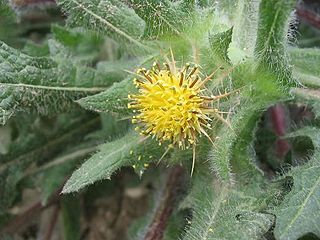
Centaurea benedicta, known by the common names St. Benedict's thistle, blessed thistle, holy thistle and spotted thistle, is a thistle-like plant in the family Asteraceae, native to the Mediterranean region, from Portugal north to southern France and east to Iran. It is known in other parts of the world, including parts of North America, as an introduced species and often a noxious weed.

Carduus crispus, the curly plumeless thistle or welted thistle, is a biennial herb in the daisy family Asteraceae. C. crispus is native to multiple different countries all over Europe and Asia, but it is also naturalized in North America. These plants have specific environmental conditions such as the type of soil and the amount of sunlight that must be met before they can grow. There is a breakdown of the species Carduus crispus that tells us the origin and the meaning of each part of the species' name. The leaves, flowers and fruit of this species are described, as well as, the medicinal and wildlife uses.

Verbascum blattaria, the moth mullein, is a flowering biennial plant belonging to the figwort family Scrophulariaceae. A native of Eurasia and North Africa, it has naturalized in the United States and most of Canada since its introduction and has become an invasive species there. It has been declared a noxious weed by the state of Colorado.
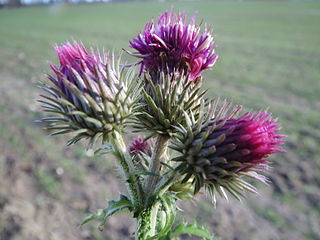
Carduus acanthoides, known as the spiny plumeless thistle, welted thistle, or plumeless thistle, is a biennial plant species of thistle in the family Asteraceae. The plant is native to Europe and Asia and introduced in many other areas, where it is sometimes considered an invasive species.
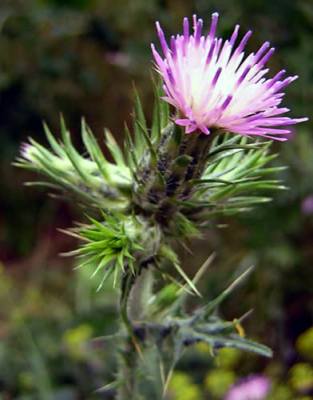
Carduus tenuiflorus, known variously as slender-flower thistle, sheep thistle, shore thistle, slender thistle, winged plumeless thistle, winged slender thistle and winged thistle, is a species of flowering plant in the family Asteraceae. It is native to Europe and North Africa, and an introduced species elsewhere.

Carthamus lanatus is a species of thistle known as woolly distaff thistle, downy safflower or saffron thistle. It is closely related to safflower. This annual plant is a native of the Mediterranean Basin, but it is familiar in other places where it was introduced and has become a noxious weed, such as in parts of North America and southern Australia with similar climates.

Cirsium neomexicanum is a North American species of thistle known by the common names New Mexico thistle, powderpuff thistle, lavender thistle, foss thistle and desert thistle.

Cirsium occidentale, with the common name cobweb thistle or cobwebby thistle, is a North American species of thistle in the family Asteraceae.

Onopordum illyricum is a species of thistle known by the common name Illyrian thistle, or Illyrian cottonthistle. It is native to southwestern Europe, but has been introduced into Australia and California, where it has become a noxious weed.

Onopordum tauricum, the Taurian thistle or bull cottonthistle, is a species of thistle. It is native to Eurasia and is known in Australia and the western United States as an introduced species. It easily becomes a noxious weed, similar to its relative, Onopordum acanthium.
Cirsium crassicaule is a species of thistle known by the common name slough thistle. It is endemic to the San Joaquin Valley of California, where it is known primarily from freshwater wetlands. It has been found in only a few locations in Kern, Kings, and San Joaquin Counties.

Cirsium undulatum is a species of thistle known by the common names wavyleaf thistle and gray thistle. It is native to much of central and western North America from British Columbia east to Manitoba and south as far as the State of Durango in Mexico. It has also been found outside of its native range as an introduced species.
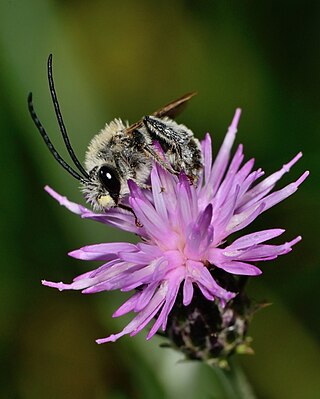
Carduus argentatus, sometimes known as the silver thistle, is an annual herb in the family Asteraceae. As a member of the genus Carduus it is known as a plumeless thistle. It is found throughout the Mediterranean and Middle East. Frequently growing in disturbed habitats, it is often found in sandy and stony desert wadis. It is found in the eastern deserts of Egypt, through the East Mediterranean region and into Iraq, Pakistan and Afghanistan. It can be found growing in open woodlands and shrublands, on steppes and semi-steppes as well as in extreme desert conditions. It grows among mountain vegetation on Mount Hermon in the Golan Heights. In Crete it is found at altitudes of up to 1,400 metres (4,600 ft).




















